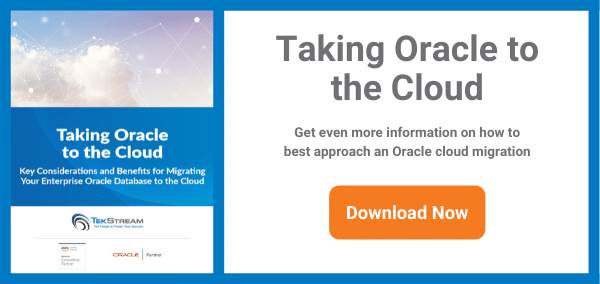Migrating Your Enterprise-Level Oracle Solution to the Cloud? Key Benefits and Drawbacks of Amazon Web Services and Oracle Cloud Infrastructure
There are a plethora of cloud platforms available to Enterprise-level companies that are exploring options for migrating their current Oracle solution to a cloud environment. While we won’t name them all, a typical shortlist is going to include platforms familiar to us all: Google Cloud Platform, Microsoft Azure, Amazon Web Services, and Oracle’s own Oracle Cloud Infrastructure.
In this blog post, we’re going to break down some of the key benefits and drawbacks of migrating your Oracle solution to two of the giants in the industry – Oracle Cloud Infrastructure (OCI) and Amazon Web Services (AWS).
Key Benefits and Drawbacks of OCI
Being a cloud-based platform, migrating to OCI also includes several essential benefits common to cloud environments, including:
- – More streamlined performance
- – Automatic software updates
- – Scalability
- – Disaster Recovery
Oracle utilizes some of the most advanced technologies to deploy its fully autonomous and scalable Autonomous Data Warehouse and Autonomous Transaction Processing for data warehousing and OLTP workloads, respectively. These technologies support the more advanced Oracle database features such as RAC, Data Guard, Redaction, Encryption, etc.
Another core benefit of choosing OCI as your Cloud platform of choice; the traditional data maintenance/migration utilities like Golden Gate, Data Guard, RMAN, etc. are supported on the Database as a Service offering.
So, how does it differ from AWS? A key differentiator from AWS, the autonomous and advanced features of Oracle databases, is only available on OCI.
It can’t be all benefits though; OCI also has its specific drawbacks. Chiefly, OCI services tend to have a high licensing cost, which can make OCI cost-prohibitive for small to medium workloads – and by extension – small and medium businesses.
Also, OCI’s lack of a live chat feature with skilled support personnel can mean a frustrating troubleshooting experience for companies making the migration to OCI.
Key Benefits and Drawbacks of AWS
As a longstanding leader in the Cloud technology space, AWS has built a strong reputation as a trusted cloud-partner for thousands of Enterprise companies. Plus, they have one of the most robust cloud-based offerings on the market through their AWS ecosystem.
When it comes to supporting Oracle on a cloud environment, AWS has integrated Oracle databases as part of its main Relational Database Service (Amazon RDS) offering. Amazon RDS is provided as part of the managed service and includes a reasonably comprehensive list of features that complement the base functionality of Oracle.
These features include:
- – Additional monitoring and metrics
- – Managed deployments for software patching and push-button scaling
- – Automated backup
AWS also provides an opportunity for companies to review their Enterprise Edition license, as it delivers similar technologies to Oracle’s Tuning and Diagnostic Packs as part of the base license.
So, what are the drawbacks of using AWS to support your Oracle Cloud migration? The most critical disadvantage of AWS is that it has the potential to be difficult and expensive to run some of the more robust oracle features found in Oracle Enterprise, including Data Guard, Management Packs, and Advanced Security. Something to keep in mind if you are using these additional features.
AWS or OCI, Which Is Right for You?
There is no single right answer. Both platforms have their advantages and their drawbacks when it comes to supporting your business’s cloud-based Oracle needs. The “right” platform will be the one that best supports your specific business criteria.
If at any time you have questions concerning your specific cloud migration needs, please reach out to TekStream. Our team of Oracle experts has years of proven experience navigating the cloud-migration needs of our partners.
We also encourage you to download our eBook, “Taking Oracle to the Cloud: Key Considerations and Benefits for Migrating Your Enterprise Oracle Database to the Cloud” for even more information on how best to approach an Oracle cloud migration.
If you’d like to talk to someone from our team, fill out the form below.


